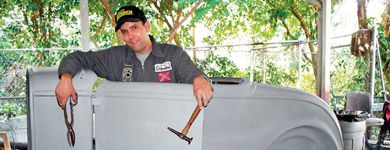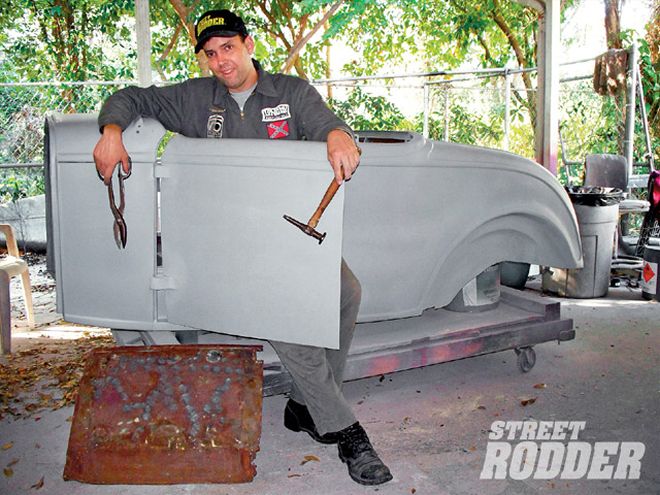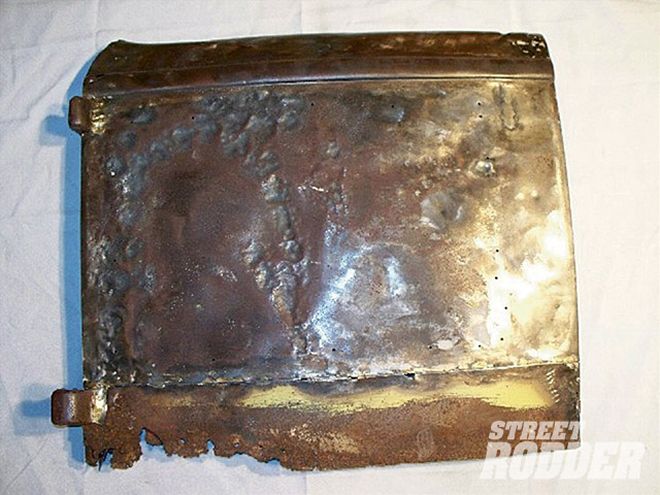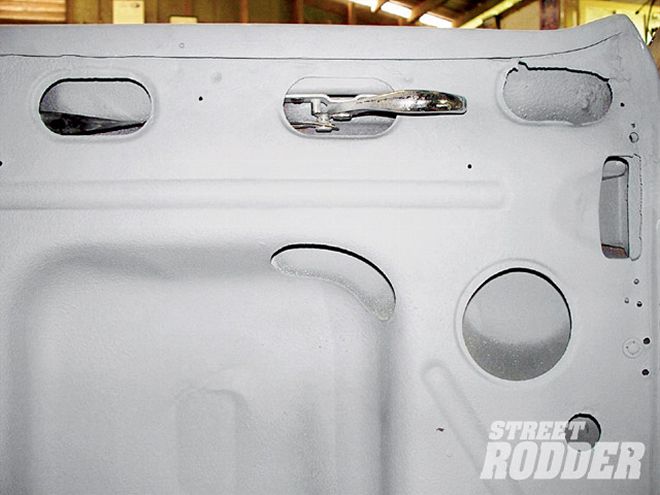

Sometimes it's convenient to replace parts. It's certainly easier and sometimes even cheaper. So why not cave in? Well, maybe the car has a history. Perhaps the reproduction parts aren't exactly the same. Sometimes it's both. This is one of those cases.
Chuck and Mike Longley have a knack for finding impossible treasure. Probably their most recognizable one was Pete Henderson's Deuce roadster. Christened one of the 75 Most Significant 1932 Ford Hot Rods and displayed at the 57th Grand National Roadster Show's special exhibit bearing the same name, one of the car's claims to fame was beating a quarter horse campaigned by a traveling huckster. That was 1946, and the car seemed to only get more famous over the years. It achieved likely its height of fame by appearing in B-grade flicks, most notably Hot Rod Gang.
 Once Mike and Chuck melted the lead off the doors, this is what they found. As the story goes, Jerry Stroner sold the car to Leroy Holmes, who extended the headers down the sides of the car. The headers interfered with the doors, so he did what came naturally to a kid in the '40s: he cut off their bottoms. A subsequent owner then raced it on dirt tracks. Ostensibly to shrink the doorskin, someone haphazardly applied incredible amounts of torch heat to it, causing it to dimple dramatically. As Mike Longley put it, "It looked like everybody took a whack at it with a ball-peen hammer."
Once Mike and Chuck melted the lead off the doors, this is what they found. As the story goes, Jerry Stroner sold the car to Leroy Holmes, who extended the headers down the sides of the car. The headers interfered with the doors, so he did what came naturally to a kid in the '40s: he cut off their bottoms. A subsequent owner then raced it on dirt tracks. Ostensibly to shrink the doorskin, someone haphazardly applied incredible amounts of torch heat to it, causing it to dimple dramatically. As Mike Longley put it, "It looked like everybody took a whack at it with a ball-peen hammer."
The duo also has a knack for resurrecting lost causes. Even in today's market, when beat-down Deuce roadster bodies still command five figures, that car would've been a hard sell when they found it. Channeled by a subsequent owner and rolled end-over-end four times on a production set, the car was a goner. But they brought it back to such a high level of quality that the car was asked to compete in the '07 Pebble Beach Concours d'Elegance. Sadly, the car was practically totaled by the carrier on the way there, but that's another story.
Recently the Longleys stumbled upon another car with a hot rod history. Jerry Stroner and his fellow Road Runners club members Ken Crawford and Pete Henderson--yes, the guy with the other roadster--built and raced it at the lakes immediately after the war. Probably its most significant cultural achievement was appearing in an article that Look magazine published to showcase the positive side of hot rods. That was in 1947, and many consider Jerry's car to be the first hot rod ever featured in a national publication.
But every silver lining has a cloud. Through a succession of sales, a vet returning from service in Korea ended up buying the car and taking it back with him to the Midwest, ostensibly thinking that a hot lakes car would tear up the tracks. Only the tracks tore up the car. And of all the parts on the car, the doors took probably the hardest knocks. In fact, most restorers would have written them off as dead and bought reproductions.
There's only one problem: the replacements are different. Sure, they're high quality and more than passable as the real article; however, they don't have a few telltale things, like the flares around the inner-door access holes or the specific shape at the top of the door. To most people those are moot points, but to highly idealistic and uncompromised builders they're signs of caving in. And to the Longleys, the whole point is to restore as much as possible. After all, it would be easier to just start with a die-perfect body, right?

Before we launch into what they did to resurrect these doors, we feel it's important to reveal one of the elements that distinguishes their work: for the most part they limit themselves to the tools available to a kid building a hot rod half a century ago. For example, as far as they're concerned, plasma cutters and TIG and MIG welders don't exist. If a kid couldn't have welded it with acetylene or a buzz box in 1949, the Longleys won't do it in 2009. They make a few concessions for air tools and abrasives, as the work they do requires a lot of restoration; however, they draw the line on anything that would reveal itself in the final product. So instead of finding miniscule TIG beads, you'll see laboriously planished gas welds.
What emerges are cars that are not only faithful to their original shape but accurate in their construction. Each is a rolling testimony to our past. Here's how they do it.